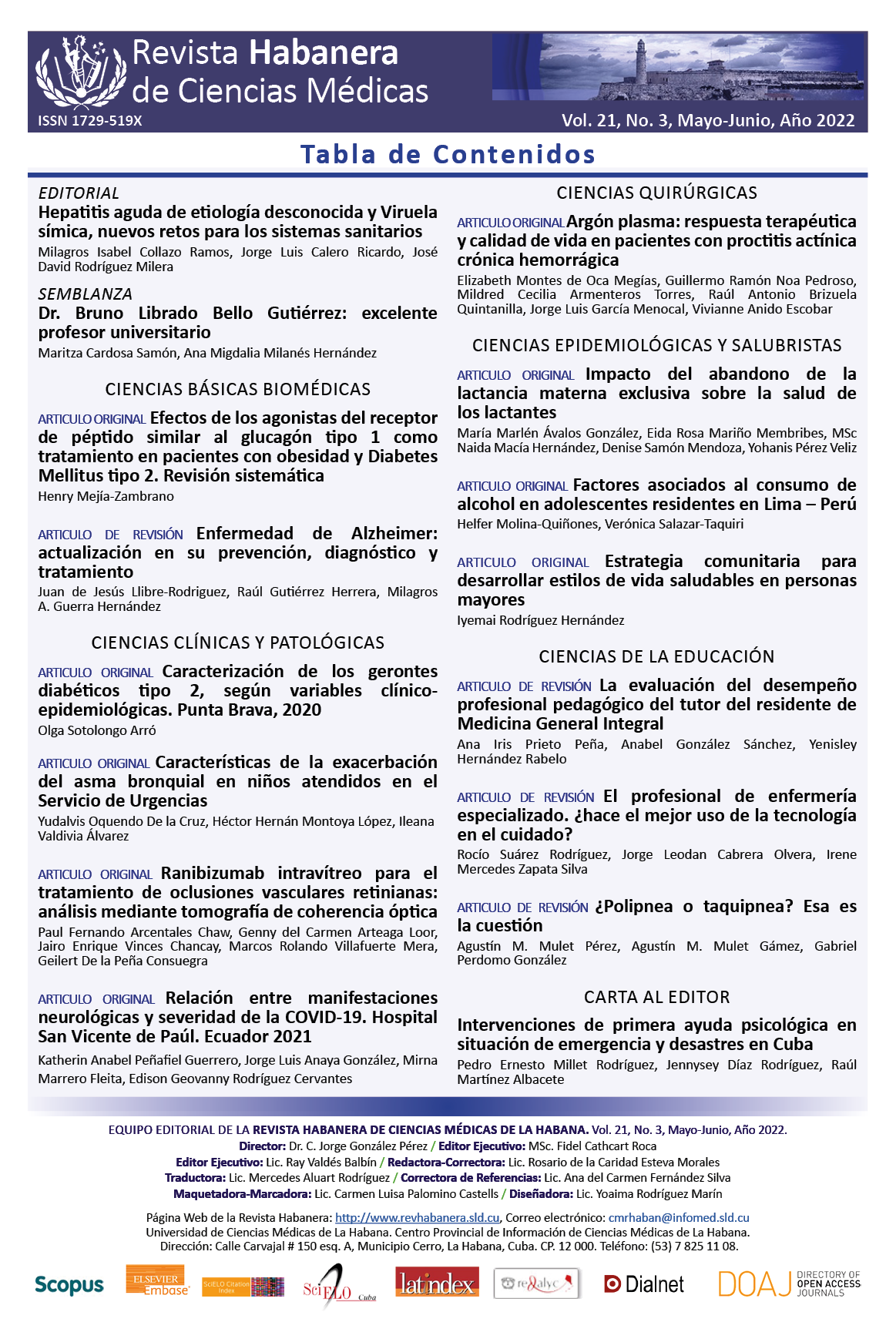Intravitreal Ranibizumab for the Treatment of Retinal Vascular Occlusions: Analysis Using Optical Coherence Tomography
Keywords:
Retinal vein occlusion, retinal artery occlusion, risk factors, retina, Optical Coherence Tomography.Abstract
Introduction: The use of the intravitreal ranibizumab favors the reduction of the macular edema that generates retinal vascular occlusions that cause visual loss.
Objective: To evaluate the efficacy and safety of the intravitreal administration of ranibizumab in the change in central macular thickness in retinal vascular occlusions analyzed by optical coherence tomography.
Material and methods: A retrospective, analytical, correlational and observational field study with a non-experimental design was carried out on 125 patients over 30 years of age diagnosed with retinal vascular occlusion in the Ophthalmology Service of “Teodoro Maldonado Carbó” Hospital during the period between January 2017 and June 2018. The ANOVA technique was used to compare means in order to determine, through the hypothesis contrast process, if there are statistically significant differences between them.
Results: Visual acuity analysis using the logMAR scale showed statistically significant differences between the averages obtained 3 months before and after the application of the treatment (p = 0.0001). In addition, 28,8 % of adverse effects were found. The most frequent ones included increased intraocular pressure (4 %), dry eyes (16 %), and conjunctival hemorrhage (11,2 %).
Conclusions: In retinal vascular occlusions, Ranibizumab provides a better corrected visual acuity in relation to macular thickness, favors the development of new blood vessels from pre-existing vessels from endothelial cell migration.
Downloads
References
1. Kim Jae H, Chang Young S, Kim Jong W, Kim Chul G, Lee Dong W. Intravitreal ranibizumab for macular edema secondary to retinal vein occlusion. Ophthalmologica [Internet]. 2017;227(3):132-8. Disponible en: http://doi.org/10.1159/000334906
2. Koyagui Y, Yoshida S, Kubo Y, Yamaguchi M. Comparison of the effectiveness of intravitreal ranibizumab for the treatment of diabetic macular edema in vitrectomized and non-vitrectomized eyes. Ophthalmology. 2017;238(Supl 1):21-7.
3. Rey, B. Algunas consideraciones sobre el edema macular diabético. MEDISAN [Internet]. 2017 [Citado 06/04/2021];21(5), 628-34. Disponible en: http://scielo.sld.cu/scielo.php?script=sci_arttext&pid=S1029-30192017000500018
4. Sociedad Oftalmologica de la Comunidad Valenciana. Anatomía del ojo [Internet]. Valencia: SOCV; 2014 [Citado 06/04/2021]. Disponible en: http://www.socv.org/anatomia-del-ojo/
5. Schutze, C. Imágenes para BRVO y CRVO [Internet]. EE UU: Retina Today; 2011 [Citado 06/04/2021] Disponible en: https://retinatoday.com/articles/2011-may-june/imaging-for-brvo-and-crvo
6. Turello M, Pasca S, Daminato R. Retinal vein occlusion: evaluation of "classic" and "emerging" risk ant treatment. J Thromb Thrombolysis. 2010;29(4):459-64.
7. Pineda S, Carriosa M. Clinical aspects relevant to the diagnosis of retinal venous occlusions: A review. Cien Tecnol Salud Vis Ocul [Internet]. 2016 [Citado 06/04/2021];15(1):91-111. Disponible en: https://repositorioslatinoamericanos.uchile.cl/handle/2250/1142962
8. Keren S, Loewenstein A, Coscas G. Pathogenesis, prevention, diagnosis and management of of retinal vein occlusion. World J Ophthalmol [Internet]. 2014 [Citado 06/04/2021];4(4):92-112. Disponible en: https://www.cnki.com.cn/Article/CJFDTotal-WJOM201404001.htm
9. Arellano G, Paralva J, Moncayo C, Maldonado G, Mendoza S. Fármacos antiangiogenicos en enfermedades neovasculares de la retina. Rev Científica Ciencias Médicas [Internet]. 2017 [Citado 06/04/2021];20(1):31-7. Disponible en: http://www.scielo.org.bo/scielo.php?pid=S1817-74332017000100007&script=sci_arttext&tlng=pt
10. Instituto Nacional Estadisticas de Ecuador. Anuario de Estadísticas Hospitalarias Camas y Egresos [Internet]. Ecuador: INEE; 2018 [Citado 06/04/2021]. Disponible en: http://www.ecuadorencifras.gob.ec/documentos/web-inec/Estadisticas_Sociales/Camas_Egresos_Hospitalarios/Publicaciones-Cam_Egre_Host/Anuario_Camas_Egresos_Hospitalarios_2012.pdf
11. Bailey IL, Lovie JE. New design principles for visual acuity charts. Am J Optom Physiol Opt [Internet]. 1976 [Citado 06/04/2021];53:740–5. Disponible en: Disponible en: https://europepmc.org/article/med/998716
12. Lida Y, Muraoka Y, Oot S, Murakami T. Morphological and functional changes of the retinal vessels in the retinal vein occlusion of the branch: angiography study by optical coherence tomography. Am J Ophthalmol. 2017;182:168-79.
13. López M. Encuesta de ceguera y deficiencia visual evitable en Panamá. Rev Panam Salud Publica [Internet]. 2014 [Citado 06/04/2021];36(6):[Aprox. 2 p.]. Disponible en: https://www.scielosp.org/article/rpsp/2014.v36n6/355-360/
14. Shahid, H., Hossain, P., Amoaku, WM. Tratamiento de la oclusión de la vena retiniana. La terapia individualizada es crucial para buenos resultados para el paciente [Internet]. Buenos Aires: IntraMed; 2007. [Citado 08/11/2021]. Disponible en: https://www.intramed.net/contenidover.asp?contenidoid=43431
15. Pineda S, Carriosa M. Clinical aspects relevant to the diagnosis of retinal venous occlusions: A review. Cien Tecnol Salud Vis Ocul [Internet]. 2016 [Citado 06/04/2021];15(1):91-111. Disponible en: https://repositorioslatinoamericanos.uchile.cl/handle/2250/1142962
16. MacDonald D. The ABC of OVR: a review of retinal venous occlusion. Clin Exp Optom [Internet]. 2014 [Citado 06/04/2021];97(4):311-23. Disponible en: https://www.tandfonline.com/doi/abs/10.1111/cxo.12120
17. Rehak J, Rehak M. Occlusion of retinal branch vein: pathogenesis, visual prognosis and treatment modalities. Curr Eye Res [Internet]. 2008 [Citado 06/04/2021];33(2):111-31. Disponible en: https://www.tandfonline.com/doi/full/10.1080/02713680701851902
18. Guirado L. Trombosis Venosa retiniana y Trombosis venosa profunda; hablamos de dos manifestaciones de una misma enfernedad? Estudio comparwativo de 2 cohortes [Tesis de Doctorado en Ciencias de la Salud]. Murcia: Universidad Católica de Murcia; 2018 [Citado 06/04/2021]. Disponible en: https://dialnet.unirioja.es/servlet/tesis?codigo=153438
19. Jarro I. Patologías retinianas con tomografía por adherencia óptica, en Hospital Abel Gilbert entre 2014 y 2015 [Tesis de Especialidad]. Guayaquil: Universidad de Guayaquil; 2017 [Citado 06/04/2021]. Disponible en: http://repositorio.ug.edu.ec/bitstream/redug/32283/1/CD%201755-%20JARRO%20VILLAVICENCIO%20IVAN%20GEOVANNY.pdf
20. Shiono A, Kogo J, Sasaki H, Yomoda Jujo T, Tokuda N, Kitaoka Y, et al. Optical coherence tomography findings as a predictor of clinical course in patients with branch retinal vein occlusion treated with ranibizumab. PLoS One [Internet]. 2018;13(6):e0199552. Disponible en: http://doi.org/10.1371/journal.pone.0199552
21. Haro A. Eficacia y Seguridad del tratamiento con ranibizumab intravítreo en pacientes con ranibizumab intravítreo en pacientes con DMAE húmeda y edema macular secundario [Tesis Maestria en Ciencias de la Salud]. Valladolid: Universidad de Valladolid; 2014. [Citado 06/04/2021] Disponible en: http://repositorio.ug.edu.ec/bitstream/redug/41848/1/CD-17%20Arcentales%20Chaw%2c%20Paul%20Fernando.pdf
22. Berg K. Comparison of ranibizumab and bevacizumab for neovascular age-related macular degeneration according to the treatment and extension protocol of LUCAS. Oftalmología [Internet]. 2015 [Citado 06/04/2021],:122(1):146-52. Disponible en: https://www.sciencedirect.com/science/article/abs/pii/S0161642015008878



